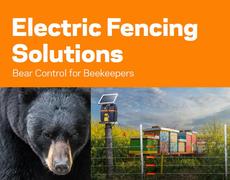A bear’s fondness for honey is legendary. The stuff even sits in little plastic, bear-shaped dispensers on grocer’s shelves. It the perfect bear food, too - protein is available as bees and honey produces carbohydrates. It’s a source of food that’s particularly desirable in the spring when hungry bears leave their winter dens.
With more than 45,000 bee colonies in Colorado, apiaries are big business. As every bee keeper knows, where there’s honey, bears aren’t far behind. In one night, a hungry bear can do at least $3,000 of damage. During peak feeding season in late summer, bears are “eating machines,” consuming up to 20,000 calories a day as they bulk up for winter hibernation. It’s that kind of potentially enormous economic damage that gives the Colorado Division of Wildlife a massive headache.
The Division is responsible because the Colorado legislature passed a law in the1930’s that requires the state to reimburse property owners for damage caused by big game. It’s why more than 100 Gallagher solar energizers are needed to keep bears out of Colorado beehives.
“The fencing program is multi-purposed; to prevent damage and to protect bears,” said Phil Ehrlich, a game damage prevention technician with the Colorado Division of Wildlife, Montrose, Colo. Noting that a hungry bear is both resourceful and intelligent, he said, “These bears have wised up and are going to get in any way they can. With an electric fence, we can educate bears and keep them out of trouble.”
The Division of Wildlife gives beekeepers a “semi-permanent” electric fence which can be set up to protect an area from 400 square feet to 1600 square feet. A Gallagher system powered by a solar energizer is used for the toughest, high-risk situations where they have an existing problem, especially the 40 by 40 yards or larger
“We’re using the Gallagher energizers in high-risk situations to lessen our liability. We wanted to be able to say we gave beekeepers the best equipment and a good system.”
Since Ehrlich began working with electric fences, no Gallagher products have been returned. “You pay a bit more, but they work,” he said.
“Bears can be tough, persistent, intelligent and aggressive animals when they want something,” Ehrlich says. “The Gallagher Energizers give us a lot of options on how to protect the beekeeper and the bear.”
According to Erwin Quinn, president of Gallagher, “An electric fence is a psychological barrier that keeps farm animals and wild animals where they should be with safety and security. Because the fence is a psychological barrier, it doesn’t require great strength to be effective. However, it must be well designed in accordance with the species to be controlled.”
The company, based in North Kansas City, Missouri, is one of the world’s largest manufacturers of electric fences designed to contain cattle, horses and other farm animals as well as prevent wild animals and predators from gaining access to areas where they can do economic damage.





